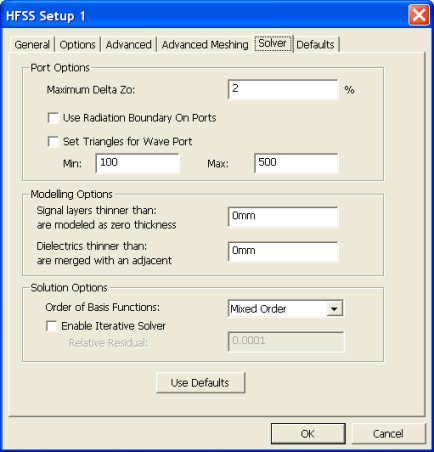|
微波射频仿真设计 |
|
|
微波射频仿真设计 |
|
| 首页 >> Ansoft Designer >> Ansoft Designer在线帮助文档 |
|
HFSS and Planar EM Simulators > HFSS Setup: Solver TabClick the Solver tab of the Add HFSS Solution Setup dialog to access the following settings.  • Port Options: • Maximum Delta Zo: change to Zo specified as a target percentage. The default is 2%. • Use Radiation Boundary On Ports: If the design includes waveports, the Use Radiation Boundary is enabled. — If you select this setting, edges which are assigned to ABC and touch a port have a radiation boundary condition applied during the port solution. — If you do not select the setting, a perfect conducting boundary condition is used during the port calculations. — In most cases this setting has a limited effect on the overall fields or post processed quantities. • Set Triangles for Wave Port: controls the number of triangles used for a wave port. For designs with lumped ports, this option is not active. Higher numbers of triangles would not benefit a solution setup in this case. — Min: minimum number of triangles on the wave port face. — Max: maximum number of triangles on the wave port face. • Modelling Options: • Signal layers thinner than <value> are modeled as zero thickness: metal signal layers in the design which are thinner than the given value are modeled as being infinitely thin in order to reduce simulation time. • Dielectrics thinner than <value> are merged with an adjacent: dielectric layers in the design which are thinner than the given value are merged into an adjacent dielectric; material properties are accumulated using a weighted average. • Solution Options: • Order of Basis Functions: the order of the basis functions HFSS uses to interpolate field values from nodal values. The Zero order option is useful when a model requires a mesh that produces more than 100,000 tetrahedra, but the model size is small compared to wavelength. The higher order options solve progressively more unknowns for each tetrahedra. Mixed order uses higher order where more accuracy is required, and lower order where fields are weaker. • Enable Iterative Solver: the iterative solver provides an alternative to the multi-frontal solver when a matrix is well-conditioned for an iterative solution. The iterative solver significantly reduces memory usage, and it can also provide a savings in the solution time for large simulations. When this option is enabled, HFSS automatically invokes the iterative solver when it decides that the matrix is conditioned well enough to take advantage of the iterative approach. HFSS uses the multi-frontal solver if the matrix does not meet this requirement. — Relative Residual: The residual measures the convergence of the iterative solver. The default value is 1E-4.
HFSS视频教程 ADS视频教程 CST视频教程 Ansoft Designer 中文教程 |
|
Copyright © 2006 - 2013 微波EDA网, All Rights Reserved 业务联系:mweda@163.com |
|